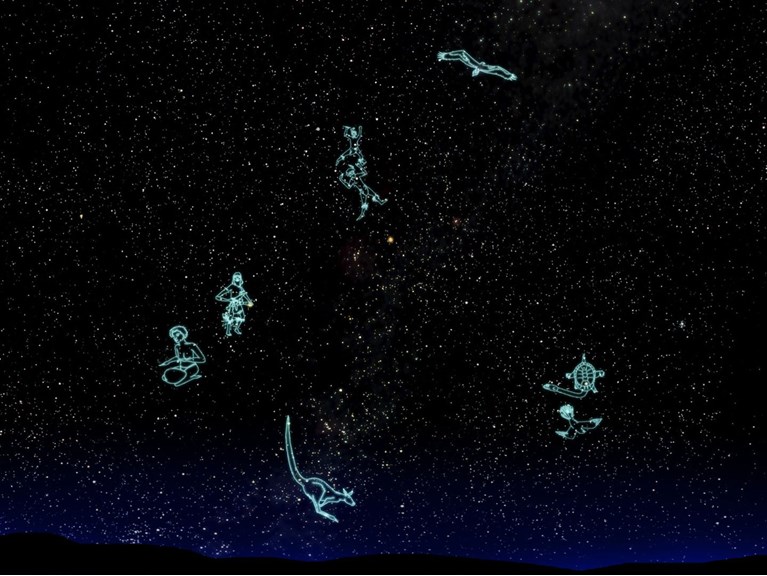First Peoples in Australia Astronomy
First Peoples cultures of Australia have a rich tradition of observing the stars. There are over 250 different language groups, each one viewing the stars a little differently. Because of this there is an amazing array of stories about the sun, moon and constellations as well as eclipses, comets, meteors and aurorae.
Seasonal changes in the stars reflect changes down here on Earth give hints about the changing seasons and when to look for certain foods. Many groups have stories about the dark patches in the sky, such as the Coalsack near the Southern Cross. For almost all First Peoples groups in Australia, the Sun was seen as a woman and the Moon as a man.
Let’s explore a few of the constellations of the Boorong people of North West Victoria!
Bunya (Bun-ya)
Bunya, the possum can be seen in the constellation known to us as the Southern Cross. The tip of the Southern Cross is the nose of the possum and his tail hangs down to the left. Bunya ran away from Tchingal, the Emu and hid in a tree for so long that he turned into a possum.
Warepil (Wah-re-pil)
The brightest star in the night sky is the centre of one of the most important Boorong constellations. That is Warepil, the male wedge-tailed eagle, chief of the Nuh-rum-bung-goo-tyas, the elders who created the land. The wings of Warepil spread to either side of Sirius across less bright stars.The wedge-tailed eagle is an important figure right across Victoria.
Kulkunbulla (Kool-koon-boo-la “oo” as in book)
Kulkunbulla, the two young dancing men, is found in one of the most recognisable constellations, the belt and the sword of Orion. Song and dance were very important to Indigenous Australian cultures, as they were one of the main ways that stories and information were remembered and passed on.
Yurree (Yoo-ree “oo” as in book) & Wanjel (Wan-jel)
Yurree and Wanjel are the two hunters who pursue Purra the kangaroo. Yurree is the fan-tailed cuckoo and Wanjel is the long-necked tortoise. They are a bright pair of stars in the sky known to Europeans as Castor and Pollux, the two twins of Gemini. The appearance of these stars in the night sky indicate seasonal patterns for both of these animals. Yurree & Wanjel reappear in the sky in late spring, when the fan-tailed cuckoo becomes active again. The stars are most prominent in the sky in late summer, when the long-necked tortoise lays its eggs.
Tchingal (Chin-gel)
Tchingal is the evil emu that terrorised people. It was hunted by the brothers Bram, and eventually killed by Weetkurrk. The battle between these helped to create the landscape of western Victoria. Tchingal is seen in the sky as a series of dark nebulae. The head of Tchingal is the Coalsack, the dark nebulae next to the Southern Cross. The neck of Tchingal goes through the two pointer stars and the body extends to the large dark nebulae near Scorpius. Unfortunately, light pollution means that the Milky Way cannot be seen from the city, so you need to go to the dark skies of the country to see Tchingal.
Brolgas
Another Boorong constellation that you need to go to the country to see are the two Brolga’s eggs, or as we call them the Magellanic Clouds. These are visible from dark skies near Melbourne all year round.
Neilloan (Nay-e-lo-en)
Neilloan is the Mallee fowl and is based around Vega, the fifth brightest star in the night sky. Neilloan is far to the north. It appears in the morning sky in autumn, when the mallee fowls start to construct their nest. It disappears from the evening sky in spring, when egg laying season begins. In late April, Neilloan is the source of the Lyrid meteor shower.
